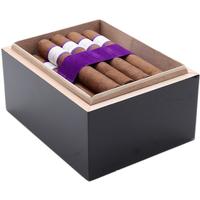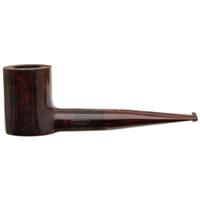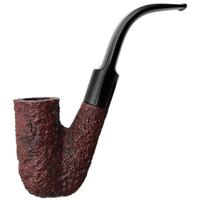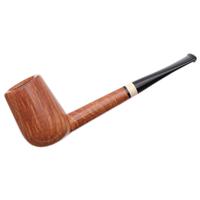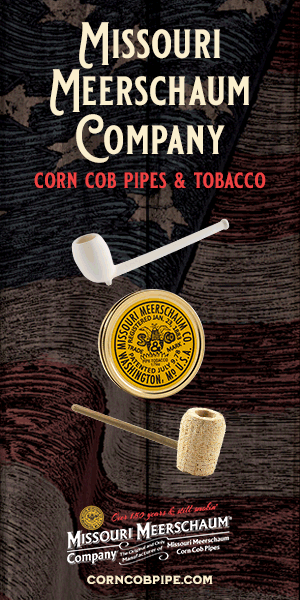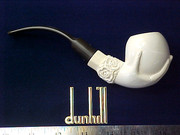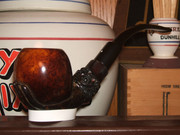I'll start off with my own musings, which are what seems to me to
be a cogent theory. Comment and divergent views are welcome, as this is
a topic that interests many, but none seem to know much about.
I've been giving some thought to the issues of flow dynamics as they
relate to Meerschaum coloring. With little else but the most rudimentary
exposure to scientific thought on flow principles long ago, my grasp of
this concept is weak. Still, it seems a topic of interest to both myself and
others. I offer these thoughts in the hopes that others will take some interest.
The combination of burning tobacco and beeswax cause Meerschaums to
color over time. OK, so what's going on? It seems that heat will cause the
wax to migrate into the Block. Continued heating/cooling cycles will cause
the wax to migrate in a progressive manner, but at some point, the wax
evaporates. This process works like a wick to the byproducts of tobacco
combustion and draws them into the Block, where they accumulate, in a
progressive result of color, that changes character over time. If I understand
it, this is the process that results in the patina that Meerschaum smokers
prize. Is this what's going on? Do I have a cogent theory in this line
of thought?
An interesting
observation to add to this is that Meerschaums that have been smoked
for long periods of time, without rewaxing, may not demonstrate a well developed
patina. When such a Pipe is rewaxed, it will quickly display colors. Like all
coloring in Meerschaums, the repetition of rewaxing in concert with smoking
the Pipe, will eventually produce coloring that does not quickly fade.
I believe that I've addressed the path of wax dissipation. Continued
heating/cooling cycles will cause the wax to migrate in a progressive
manner, but at some point, the wax evaporates. This process may
account for wax loss, but certainly some will also be lost to friction
on the Pipe's surface. I've not taken any additives that the Carver
may choose to mix in with the wax or the porosity of the Block into account.
Smoke from the tobacco smoking is giving the brown color, that is
certainly a factor. The heat and the moisture of the tobacco are also
involved. The Pipe's shank usually starts to color first, as it is the
site of major condensation via cooling, of the tobacco being smoked.
I agree that the wax protects the outer surface of the Pipe, which is
not to say that it doesn't migrate into the Block. As I understand it,
the Carver blocks off the Pipe's draft & the bowl, so that the wax does
not get into the Pipe, but this is done to avoid having the first few smokes
taste like burning wax. I also agree with you about the wax not being the
coloring agent for the Block, but instead, it serves to wick the byproducts
of the smoke along it's migration routes. The point that has me stumped,
is the quick color shown by waxing Pipes that have not been rewaxed,
but have been smoked. This suggests that some part (or all) of the nicotine,
tars & moisture are already in the Block from smoking, but do not display
this coloring as fast, if left without rewaxing. Even if the wax's role is to
wick and protect, how does it contribute to the Pipe's color. Your idea of
the wax serving to seal the Block from loss of these smoke byproducts
may be a demonstration of this idea. It is an interesting puzzle.
I've been turning this bit of a puzzle over in my mind, as it seems that
it will not let me rest. Perhaps the wax, the heat and the burning tobaccos
also interact chemically. This would explain how rewaxing a Pipe, that has
been smoked for a long period of time, will produce coloring with a rapid
permanence more dramatically than a Pipe that has been smoked less that
has been rewaxed. It is also quite possible that the Meerschaum itself plays
a part in this chemical interaction. I suspect that this has all been thought
of before, and tested by Carvers. Such knowledge would enable a Carver's
work to stand apart from the competition, and not likely to be widely known,
as with anything in the Meerschaum trades. So much is lost to us in the
guarded history of the Carver's art.
Sepiolite, formerly known as Meerschaum (sea froth), is a
non-swelling, lightweight, porous clay with a large specific
surface area. Unlike other clays, the individual particles of
sepiolite have a needle-like morphology. The high surface
area and porosity, as well as the unusual particle shape of
this clay account for its outstanding sorption capacity and
colloidal properties that make it a valuable material for a
wide range of applications
The high surface area and porosity of sepiolite account for
the remarkable adsorptive and absorptive properties of this
clay. It adsorbs vapours and odours and can absorb
approximately its own weight of water and other liquids.
Sepiolite is a non-swelling clay and its granules do not
desintegrate even when saturated with liquids.
These particles are arranged forming loosely packed and
porous aggregates with an extensive capillary network
which explains the high porosity of sepiolite and its light
weight because of the large void space.
What is unclear, at least to me is whether the
wax serves as the vehicle for the volatiles that color the Pipe, or if it is the remains
of both the wax and the volatiles as a combination that provide the color.
Whether the wax provides migration routes and serves as a vehicle for the volatiles
that result in color, or the combination of the wax and volatiles interacts with
the lattice structure of the Meerschaum is a good question, for which I have no
answer. It's also unclear how long the wax remains in the Block and whether
or not it's constituents ever fully pass from the Block. Indeed, as the Block nears
saturation, it will seep as it's smoked, to the point where I've observed older
Pipes requiring a cloth to wipe the Pipe while it's being smoked. It's a good
question as to what is actually left behind in the Block to provide the color, which
itself can range from flamingo pink to black. Another factor to consider is the character of the Meerschaum lattice structure - which is itself imbued with trace minerals, which can be seen as hues of red or green. Certainly, the more porous the Block, the more wax it can absorb and the more rapidly it can color. Prior to waxing, if the Pipe is held up to the light, the higher grades will be almost transparent, like looking at a tent at night, that is lit from within, infrequently exhibiting light red or green hues of color. The issue of coloring is certainly pleasing to observe and becomes surprisingly complex when attempting to explain. Heat drives the process and just as it serves to color, it can serve to bleed the color from a Pipe, as evidenced by reports of Pipes turning a mottled grey when smoked in temperatures below 32 deg Fahrenheit.
Yes, it would seem that once the coloration becomes established on the Block
exterior surface, then the Block interior starts to build concentrations of the
volatiles of combustion. I suspect that the Beeswax serves to provide
pathways to the Block exterior for the volatiles and act as a barrier on the
Block's surface, where they collect. Since this is a heat driven dynamic, the wax
and color migrates to the exterior as the Pipe is smoked, and retreat to the Block's
interior as the Pipe cools. Some of my Pipes are well colored. With prolonged periods
of rest, the patina fades a little, but returns with full intensity when the Pipe is smoked.
When these Pipes are hot from the smoke, the surface of the Block will seep wax that is
slightly colored from the volatiles. When cool, the wax seems to provide protection for
the Block's surface. The Beeswax serves to wick the volatiles that result in patina development.
Lately, I've been musing about how some of my Meerschaums seem to give a better performance with Virginia blends and others do much better with full English and Orientals. Allowing for quality of the Block used in the some hundred or so Meerschaums I have the good fortune to smoke, I initially thought that bit shape and general configuration of the Pipe might be a good place to start my subjective reasoning... Certainly, the Peterson P-Lip seems to set a Pipe up to perform best with Virginia blends, or at least until I smoked Baki's P-Lip, which does it's best with English and Balkan blends. Since both the new Peterson Turkish Block Meerschaums and Baki's Pipes are high grade Block, I began to consider something that I've read others discuss in the Briar community, which is that the soil that the burl grows in has a lot to do with the performance of the Pipe. OK, so there is also a lot of talk about how the drafting qualities of the Pipe come into play, but preferring to keep things relatively simple, I began to think about the clay that the raw Sepiolite comes from. In the past, Deniz has written that the Carver will smell the raw Block, among other actions, during his purchase considerations. If I knew more about how Sepiolite forms in the clay, I would have more information to make a good decision with. Even so, I lack the knowledge of what the Carver does to the Block and how this affects the smoking qualities of the Pipe. Just the same, with my limited understanding on this matter, I'm strongly drawn to the idea of how the clay affects the Sepiolite over time, before it is harvested. This opens up a can of worms over whether or not the Block contributes to the flavors of the smoke, either by the presence of trace elements or the individual absorptive qualities of the Pipe. Certainly, as the patina evolves into more of a complete matrix within the Block, the Pipe's absorptive qualities are influenced, which is an observation borne out by those fortunate enough to smoke well colored Meerschaums. Trying to take all of these variables into account only clouds the issue, at least to me. With such a lack of information, I still suspect that the clay has a big role in the individual performance of the Pipe. Hopefully, more information will be brought into this matter in the future, but for now, this is as much as I can surmise.




